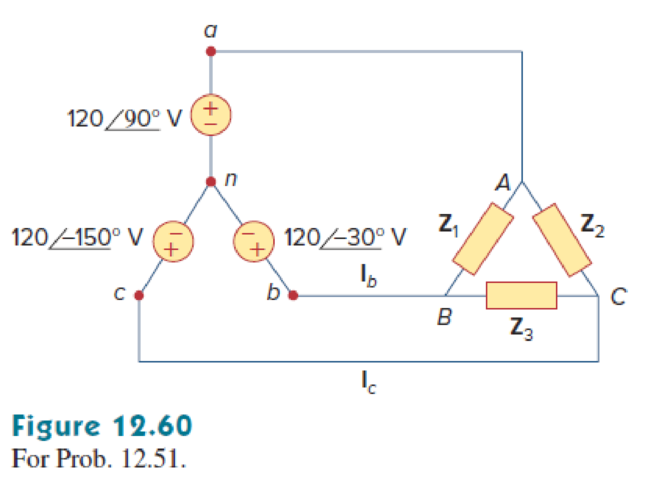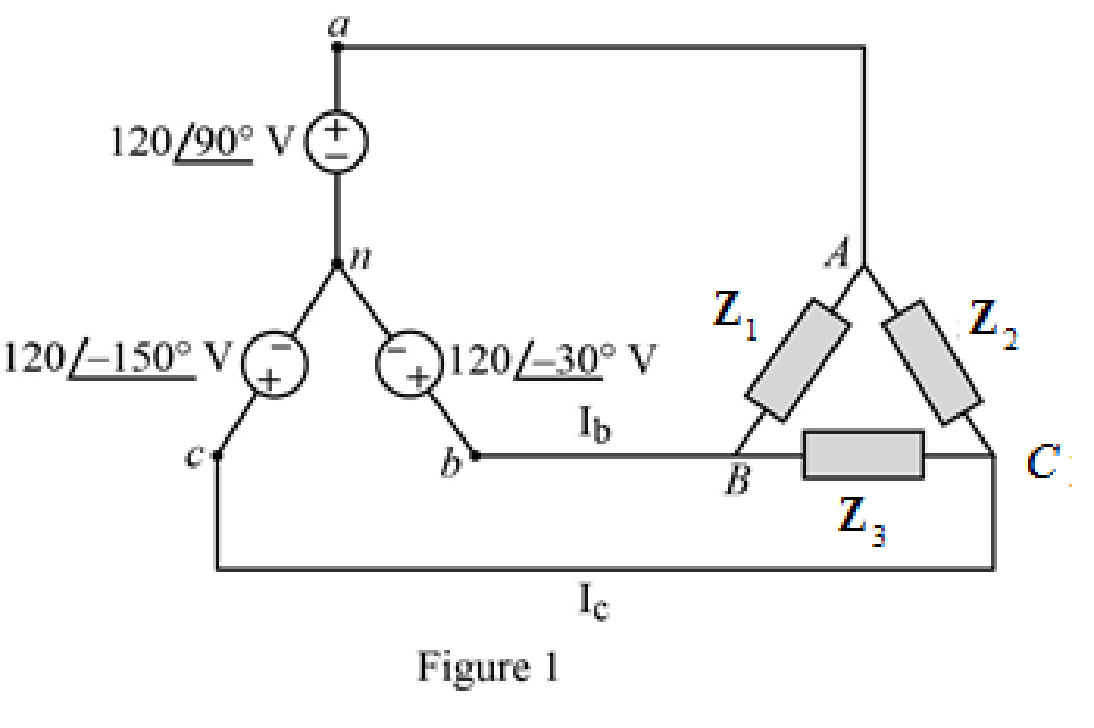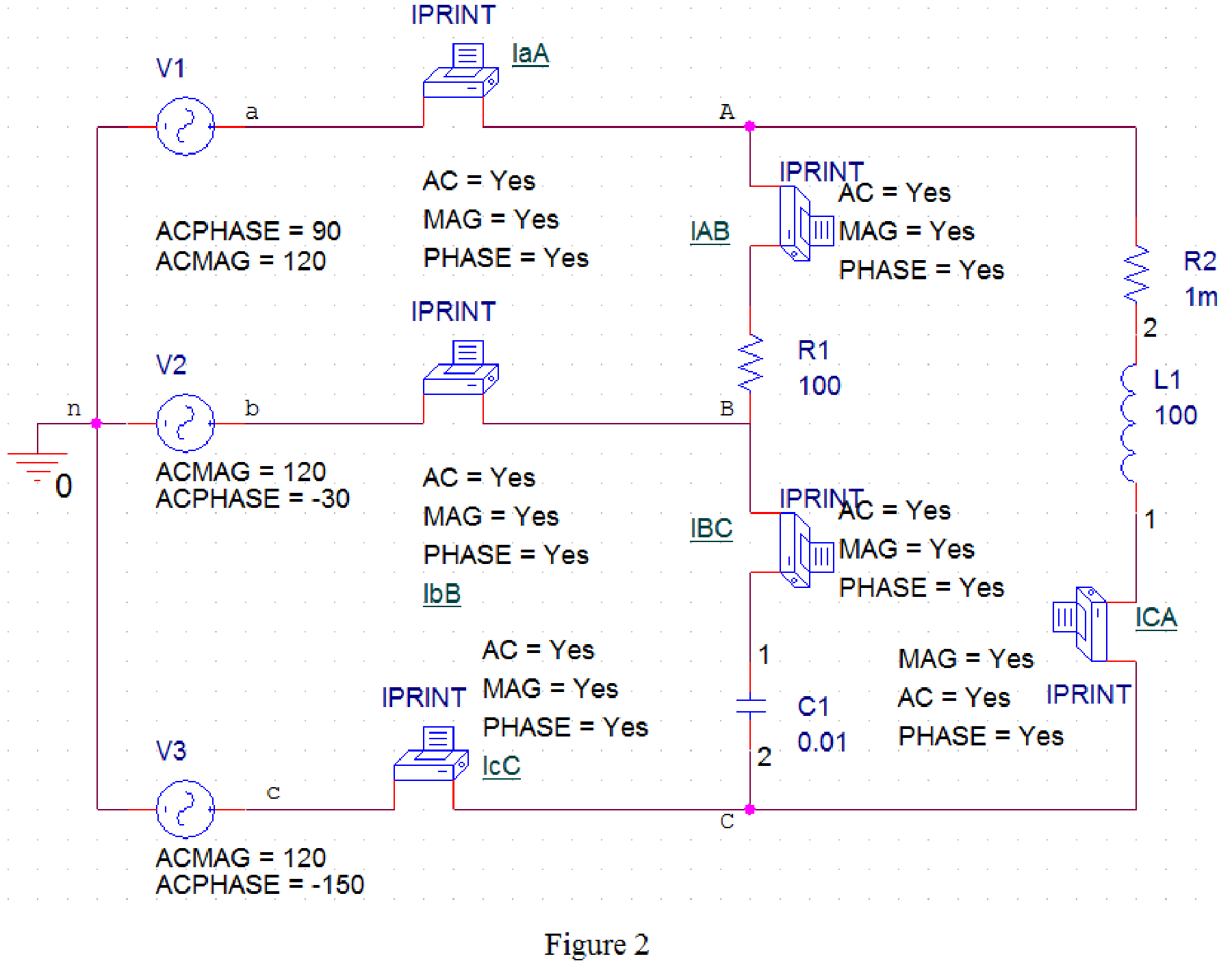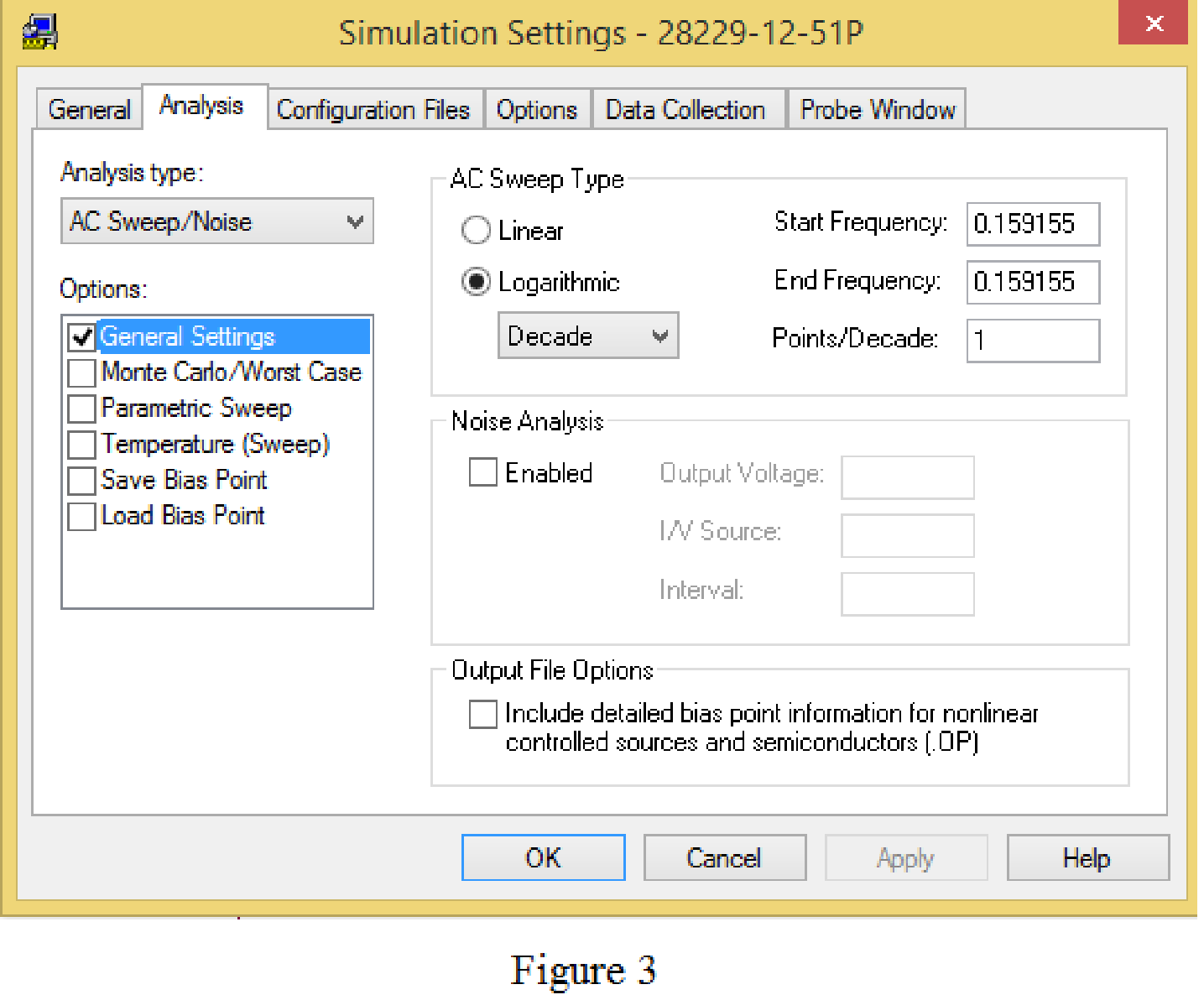
Concept explainers
Consider the wye-delta system shown in Fig. 12.60. Let

Find the phase and line currents for the
Answer to Problem 51P
The phase currents
The line currents
Explanation of Solution
Given data:
Refer to Figure 12.60 for the
In the Y-connected source:
The line to neutral voltage
The line to neutral voltage
The line to neutral voltage
In the delta-connected unbalanced load:
The impedance
The impedance
The impedance
Formula used:
Write the expression to find the line to line voltage
Here,
Write the expression to find the line to line voltage
Here,
Write the expression to find the line to line voltage
Here,
Write the expression to find the line to line current
Here,
Write the expression to find the line to line current
Here,
Write the expression to find the line to line current
Here,
Write the expression to find the line current
Here,
Write the expression to find the line current
Here,
Write the expression to find the line current
Calculation:
Re-draw the given Figure 12.60 as follows.

Substitute
Substitute
Substitute
Substitute
Substitute
Substitute
Or
Thus, the phase currents are,
Substitute
Substitute
Substitute
Thus, the line currents are,
PSpice simulation:
Assume the angular frequency
Write the expression to find the capacitive reactance.
Substitute
Write the expression to find the inductive reactance.
Substitute
Draw the circuit as shown in Figure 2 in PSpice, connect the

Provide the Simulation settings as in Figure 2.

Now, run the simulation and check the output file in newly opened PSpice A/D window.
From the PSpice results the phase currents are,
FREQ IM(V_IAB) IP(V_IAB)
1.5916E-01 2.0785E+00 1.2000E+02
FREQ IM(V_IBC) IP(V_IBC)
1.5916E-01 2.0785E+00 9.0000E+01
FREQ IM(V_ICA) IP(V_ICA)
1.5916E-01 2.0785E+00 1.5000E+02
The phase current
The phase current
The phase current
From the PSpice results the line currents are,
FREQ IM(V_IaA) IP(V_IaA)
1.5916E-01 1.0759E+00 4.5000E+01
FREQ IM(V_IbB) IP(V_IbB)
1.5916E-01 1.0759E+00 1.5000E+01
FREQ IM(V_IcC) IP(V_IcC)
1.5916E-01 2.0785E+00 -1.5000E+02
The line current
The line current
The line current
Conclusion:
Thus,
The phase currents
The line currents
Want to see more full solutions like this?
Chapter 12 Solutions
Fundamentals of Electric Circuits
- Can you rewrite the solution because it is unclear? AM (+) = 8(1+0.5 cos 1000kt +0.5 ros 2000 thts) = cos 10000 πt. 8 cos wat + 4 cos wit + 4 cos Wat coswet. J4000 t j11000rt $14+) = 45 jqooort +4e + e + e j 12000rt. 12000 kt + e +e +e Le jsoort -; goon t te +e Dcw> = 885(W- 100007) + 8 IS (W-10000) - USBarrow_forwardCan you rewrite the solution because it is unclear? Q2 AM ①(+) = 8 (1+0.5 cos 1000πt +0.5 ros 2000kt) $4+) = 45 = *cos 10000 πt. 8 cos wat + 4 cosat + 4 cos Wat coswet. j1000016 +4e -j10000πt j11000Rt j gooort -j 9000 πt + e +e j sooort te +e J11000 t + e te j 12000rt. -J12000 kt + с = 8th S(W- 100007) + 8 IS (W-10000) <&(w) = USB -5-5 -4-5-4 b) Pc 2² = 64 PSB = 42 + 4 2 Pt Pc+ PSB = y = Pe c) Puss = PLSB = = 32 4² = 8 w 32+ 8 = × 100% = 140 (1)³×2×2 31 = 20% x 2 = 3w 302 USB 4.5 5 5.6 6 ms Ac = 4 mi = 0.5 mz Ac = 4 ५ M2 = =0.5arrow_forwardA. Draw the waveform for the following binary sequence using Bipolar RZ, Bipolar NRZ, and Manchester code. Data sequence= (00110100) B. In a binary PCM system, the output signal-to-quantization ratio is to be hold to a minimum of 50 dB. If the message is a single tone with fm-5 kHz. Determine: 1) The number of required levels, and the corresponding output signal-to-quantizing noise ratio. 2) Minimum required system bandwidth.arrow_forward
- Find Io using Mesh analysisarrow_forwardFM station of 100 MHz carrier frequency modulated by a 20 kHz sinusoid with an amplitude of 10 volt, so that the peak frequency deviation is 25 kHz determine: 1) The BW of the FM signal. 2) The approximated BW if the modulating signal amplitude is increased to 50 volt. 3) The approximated BW if the modulating signal frequency is increased by 70%. 4) The amplitude of the modulating signal if the BW is 65 kHz.arrow_forwardAn FDM is used to multiplex two groups of signals using AM-SSB, the first group contains 25 speech signals, each has maximum frequency of 4 kHz, the second group contains 15 music signals, each has maximum frequency of 10 kHz. A guard bandwidth of 500 Hz is used bety each two signals and before the first one. 1. Find the BWmultiplexing 2. Find the BWtransmission if the multiplexing signal is modulated using AM-DSB-LC.arrow_forward
- An FM signal with 75 kHz deviation, has an input signal-to-noise ratio of 18 dB, with a modulating frequency of 15 kHz. 1) Find SNRO at demodulator o/p. 2) Find SNRO at demodulator o/p if AM is used with m=0.3. 3) Compare the performance in case 1) and 2).. Hint: for single tone AM-DSB-LC, SNR₁ = (2m²) (4)arrow_forwardFind Va and Vb using Nodal analysisarrow_forwardCalculate the nodal voltage in the circuitarrow_forward
- Calculate the mesh currents, find Ia, Ib, Ic. Apply mesh analysisarrow_forwardFind Va and Vb using Nodal analysisarrow_forward4. A battery operated sensor transmits to a receiver that is plugged in to a power outlet. The device is continuously operated. The battery is a 3.6 V coin-cell battery with a 245mAHr capacity. The application requires a bit rate of 36 Mbps and an error rate of less than 10^-3. The channel has a center frequency of 2.4 GHz, a bandwidth of 10 MHz and a noise power spectral density of 10^-14 W/Hz. The maximum distance is 36 meters and the losses in the channel attenuates the signal by 0.25 dB/meter. Your company has two families of chips that you can use. An M-ary ASK and an M-ary QAM chip. The have very different power requirements as shown in the table below. The total current for the system is the current required to achieve the desired Eb/No PLUS the current identified below: Hokies PSK Chip Set Operating Current NOT Including the required Eb/No for the application Hokies QAM Chip Set Operating Current NOT Including the required Eb/No for the application Chip ID M-ary Voltage (volts)…arrow_forward
 Power System Analysis and Design (MindTap Course ...Electrical EngineeringISBN:9781305632134Author:J. Duncan Glover, Thomas Overbye, Mulukutla S. SarmaPublisher:Cengage Learning
Power System Analysis and Design (MindTap Course ...Electrical EngineeringISBN:9781305632134Author:J. Duncan Glover, Thomas Overbye, Mulukutla S. SarmaPublisher:Cengage Learning
